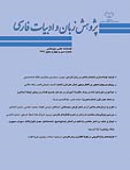از سيمرغ اوستا تا سيمرغ بلورين
محورهای موضوعی : پژوهشهای ادبیات کلاسیک ایرانفريده داوودي مقدم 1 , زهرا عسگري 2
1 - دانشگاه شاهد
2 -
کلید واژه: اسطوره هنر ایرانی سيمرغ دورۀ معاصر,
چکیده مقاله :
با توجه به نقش كهن الگويي سيمرغ در ميان صاحبان قلم و هنر، شاهد حضور پر رنگ سيمرغ در متون كلاسيك فارسي در كاركردهـاي مختلفـي اعـم از اسطوره اي، حماسي، فلسفي، عرفاني و... هستیم. از اين ميان در دورههاي نخستين، اين موجود متشكّل از هيئت پرندگان، انسان، خدايان، فرشتگان و... است كه به دليل تأثيري كه از حضور اسطوره میگیرد، شكل ها، ويژگيها و كاركردهاي مختلفي دارد. حال آنكه در دنياي معاصر، سيمرغ ديگر موجودي عجيب و پيچيده نيست، بلكه چه در حوزة ادبيات و چه ساير هنرهـا، تنهـا پرنده اي است پر نقش و نگار. اين موضوع نشان می دهد که سيمرغ در دورۀ گذار تاريخي به دنياي هنر و ادبيات معاصر، از تجرّد به عينيّت رسيده است و در حوزۀ شعر معاصر نيز به جاي پيشرفت و يا حداقل توقف در کارکردهای فاخر پيشين، از مقام نخستين خود نيز تنزّل نموده است.
According to the role of Simorgh (Roc) archetype among authors and artists, we see effective presence of Simorgh in classical Persian texts having different functions like mythical, epic, philosophical, mystical and so on roles. Among these functions, it has shapes of birds, human, gods, and angels and so on in early periods; and it has different forms, features, and functions due to presence of myth; while in contemporary world, Simorgh is no longer a strange and mysterious being, and it is a multi-patterned bird in literature and other forms of art. This shows that Simorgh has got to objectivity from abstraction in the historical transition to contemporary art and literature; and it has declined from its original fine status in contemporary poetry instead of improving or at least stopping in being applied in previous sublime uses.


